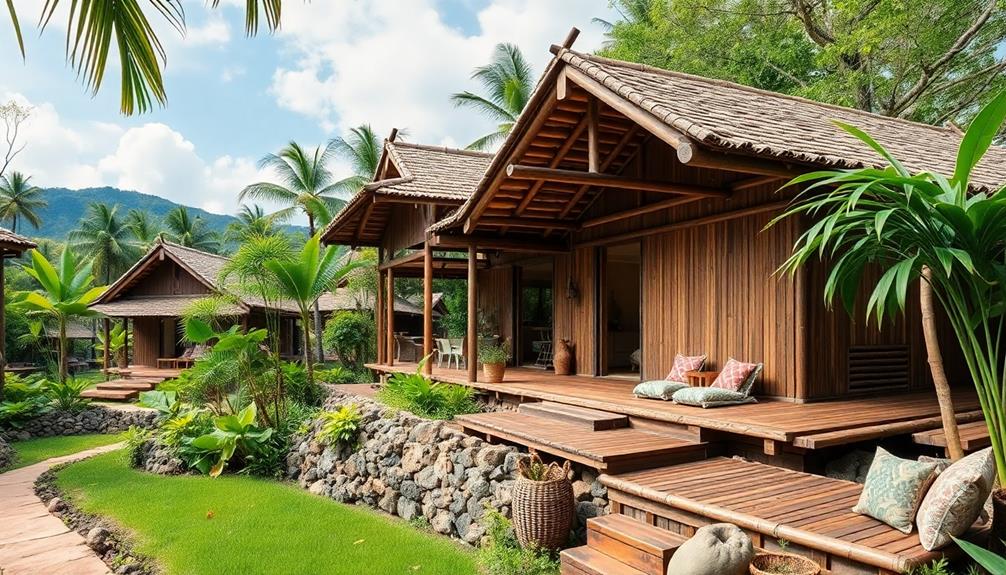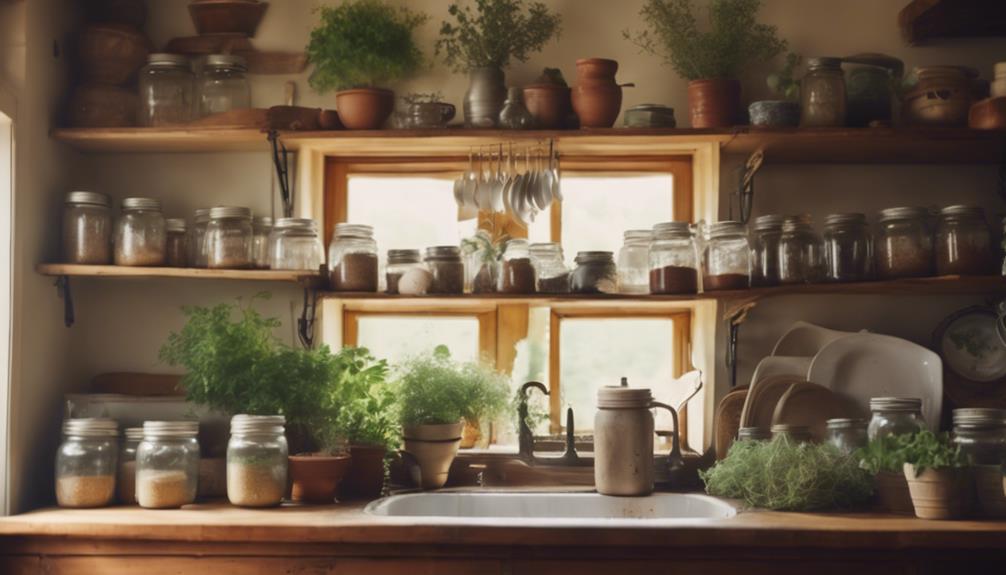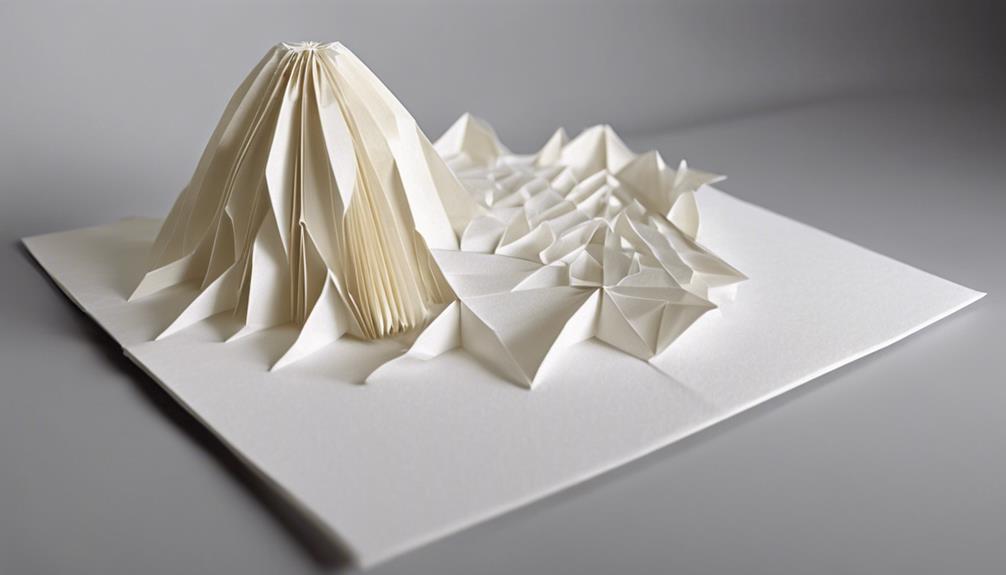Choosing sustainable materials in Indonesian design isn't just about protecting the environment; it's also about honoring cultural heritage and boosting local economies. By using locally sourced materials like bamboo and cassava plastic, you minimize transportation emissions and reduce your carbon footprint. These materials not only enhance energy efficiency but also support traditional craftsmanship. Plus, opting for sustainable options can save costs and create job opportunities in the community. As you explore the world of sustainable materials, you'll discover even more benefits that align with Indonesia's unique resources and innovative practices.
Key Takeaways
- Sustainable materials reduce the environmental impact of construction, supporting Indonesia's commitment to ecological preservation and carbon emission reduction.
- Utilizing local resources enhances job creation and supports community development while minimizing transportation emissions and costs.
- Incorporating traditional materials like bamboo and seaweed fosters cultural heritage integration in modern design, honoring local craftsmanship.
- Innovative design techniques using lower embodied energy materials contribute to energy efficiency and optimize building performance while minimizing waste.
- Consumer demand for eco-friendly products is rising, driving the construction sector towards sustainable solutions that align with modern values and preferences.
Importance of Sustainable Materials
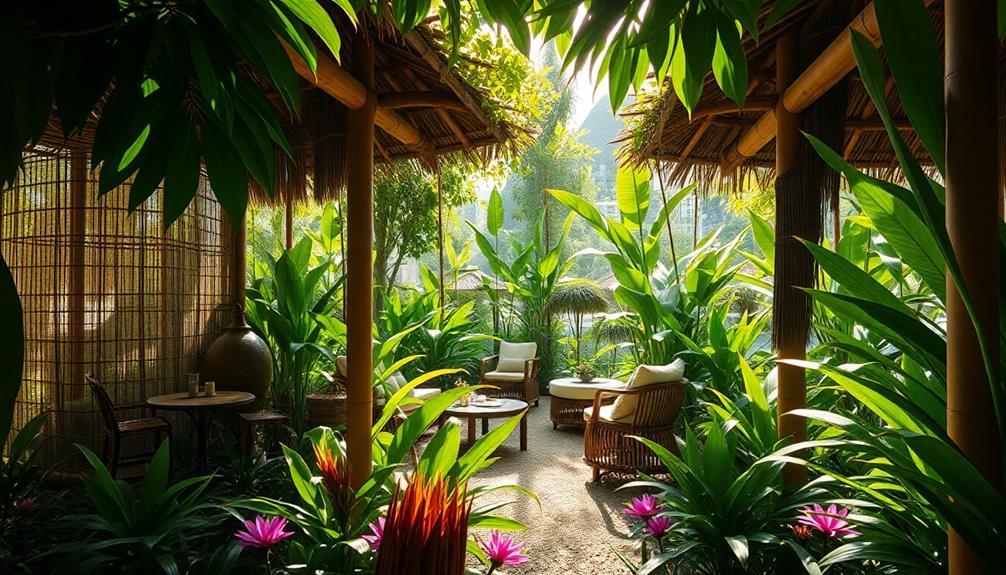
The importance of sustainable materials in Indonesian design can't be overstated. By choosing sustainable materials, you help reduce the environmental impact of construction projects.
Locally sourced resources minimize transportation emissions and support local economies, making a positive difference in your community. Additionally, sustainable materials often align with the principles of Balinese design characteristics, which emphasize eco-friendly options and a connection to nature.
Using these materials appreciably lowers embodied energy, as alternatives like recycled concrete and bamboo require less energy for extraction and processing compared to conventional options. This not only boosts energy efficiency but also aligns with the increasing consumer demand for eco-friendly solutions.
With the sustainable packaging market projected to reach USD 5.51 billion by 2029, it's clear that more people are prioritizing sustainable choices.
Furthermore, adopting sustainable materials aids in biodiversity conservation by reducing deforestation and promoting renewable resources, an essential step given Indonesia's rank of 133 out of 180 in the Environmental Performance Index.
Benefits of Local Resource Utilization
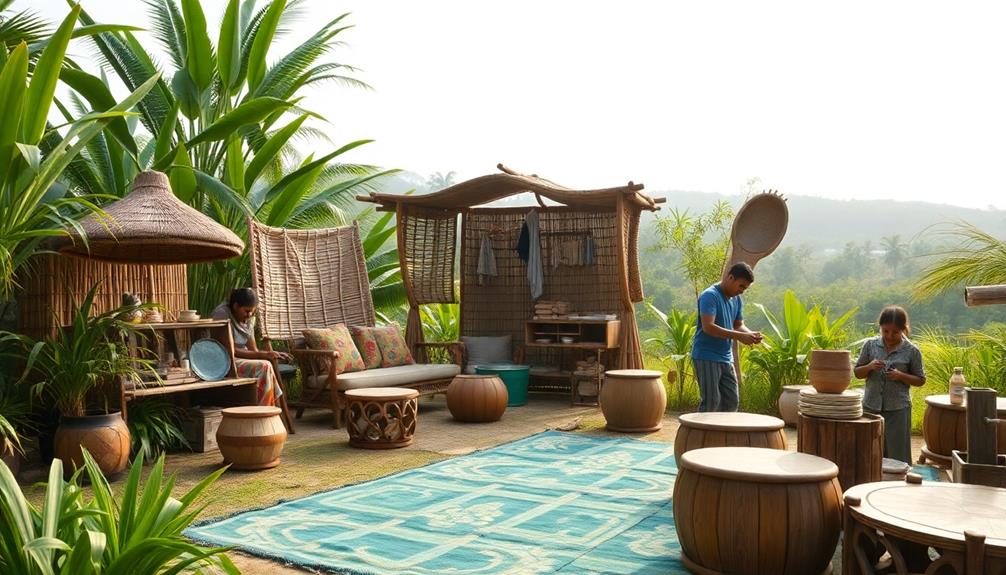
Choosing sustainable materials not only benefits the environment but also highlights the advantages of utilizing local resources in Indonesian design. By sourcing materials like bamboo and reclaimed wood, you're reducing transportation emissions, which considerably lowers the carbon footprint associated with building projects.
This practice not only reflects Indonesia's rich biodiversity but also supports the preservation of traditional craftsmanship and cultural heritage, as seen in the vibrant artistry of Indonesian Decor Masks that tell stories of local traditions.
Using local resources enhances the economy by creating job opportunities and supporting local businesses, fostering community development. You'll find that opting for indigenous materials often leads to cost savings due to reduced logistics and transportation expenses, making sustainable design more economically viable.
Moreover, incorporating local resources can improve a building's compatibility with the local climate, enhancing energy efficiency. This means you can rely less on artificial heating and cooling systems, leading to reduced energy consumption.
Ultimately, embracing local resources in your designs not only promotes environmental sustainability but also strengthens the community and showcases the unique cultural identity of Indonesia. By choosing local, you're making a positive impact on both the planet and the people.
Reducing Embodied Energy
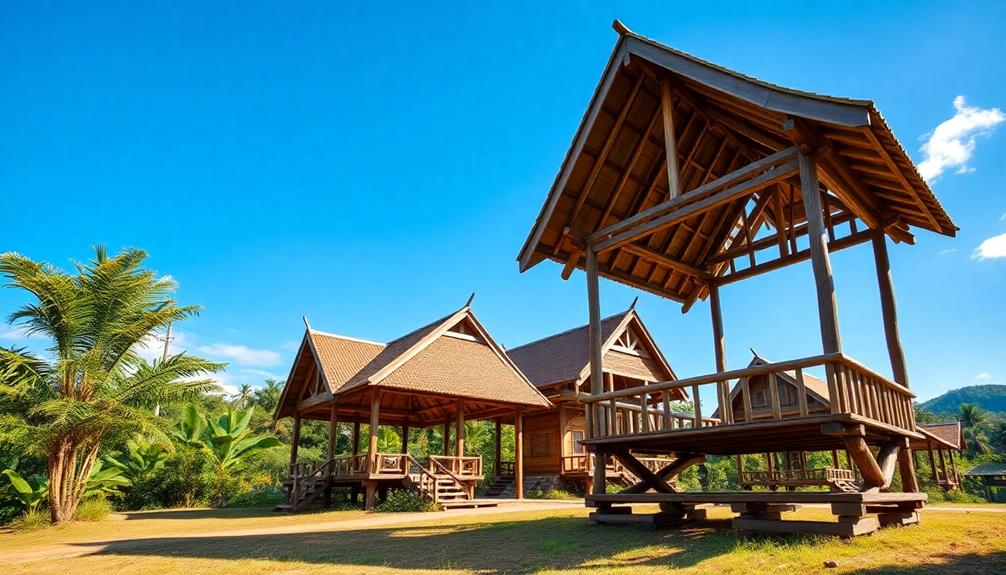
When you choose materials for your design, consider their embodied energy and how it affects your project's overall efficiency.
Utilizing traditional Indonesian housing practices can further enhance sustainability, as they often incorporate local and renewable resources.
Innovative design techniques and local green materials can greatly cut down on energy consumption, making a positive impact from the start.
Material Selection Strategies
Reducing embodied energy in building design starts with smart material selection. By choosing materials with lower embodied energy, you can markedly decrease energy consumption in your projects. Innovative design choices have shown potential reductions of up to 39% in energy use, especially when considering alternative floor slab options.
Incorporating Indonesian decorative pillows and other local textiles not only enhances the aesthetic appeal of your interiors but also supports sustainable practices by utilizing traditional craftsmanship.
Remember, the embodied energy of a building includes the extraction, production, transportation, and maintenance of materials. This makes your material selection essential in minimizing environmental impacts throughout the building's lifecycle.
Opting for local green materials not only reduces the carbon footprint linked to transportation but also supports compliance with local regulations, ensuring you have the necessary documentation for sustainable practices.
Utilizing ecolabels aligned with green building assessment criteria can help you evaluate the lifecycle energy consumption of materials. This promotes informed decision-making in your selections.
Additionally, effective waste management practices during the production phase enhance materials' potential for reuse and recycling, contributing to overall efficiency and sustainability in your building projects.
Innovative Design Techniques
Innovation in design techniques plays an essential role in minimizing embodied energy within building projects. When you make innovative design choices, like opting for alternative floor slab options, you can achieve energy savings of up to 39%. This early stage decision-making greatly lowers the total embodied energy of your building materials throughout their lifecycle.
Incorporating traditional Indonesian style home decor principles can further enhance sustainability by utilizing natural materials that harmonize with the environment. By selecting local green materials, you not only reduce transportation energy but also guarantee compliance with legality and supporting documentation requirements in Indonesia.
When you utilize materials with lower embodied energy—such as compressed earth blocks (CEB) and recycled concrete—you enhance both efficiency and sustainability in your architectural projects. Moreover, effective material selection strategies contribute to passive design features, optimizing overall building performance and resource consumption.
These environmentally friendly approaches allow you to create structures that aren't just aesthetically pleasing but also aligned with sustainable practices. Ultimately, integrating innovative design techniques in your projects can lead to considerable reductions in embodied energy, making a positive impact on the environment while also meeting the demands of modern architecture in Indonesia.
Lifecycle Energy Assessment
Lifecycle energy assessment serves as an essential tool for architects and builders aiming to minimize embodied energy in their projects.
By evaluating the total embodied energy of materials—from extraction to production, transportation, and maintenance—you can identify opportunities to reduce overall energy consumption in your designs.
Utilizing sustainable craftsmanship in Balinese furniture can further enhance your approach by integrating local materials into your project.
Consider these strategies when conducting a lifecycle energy assessment:
- Choose local green materials to cut transportation costs and support local regulations.
- Opt for alternative floor slab options that can save up to 39% in embodied energy.
- Focus on passive design features that enhance building efficiency through effective material selection.
- Incorporate recycled materials to promote sustainability and reduce waste.
- Ensure accurate data collection to avoid miscalculations that hinder effective sustainability practices.
Innovations in Biodegradable Materials
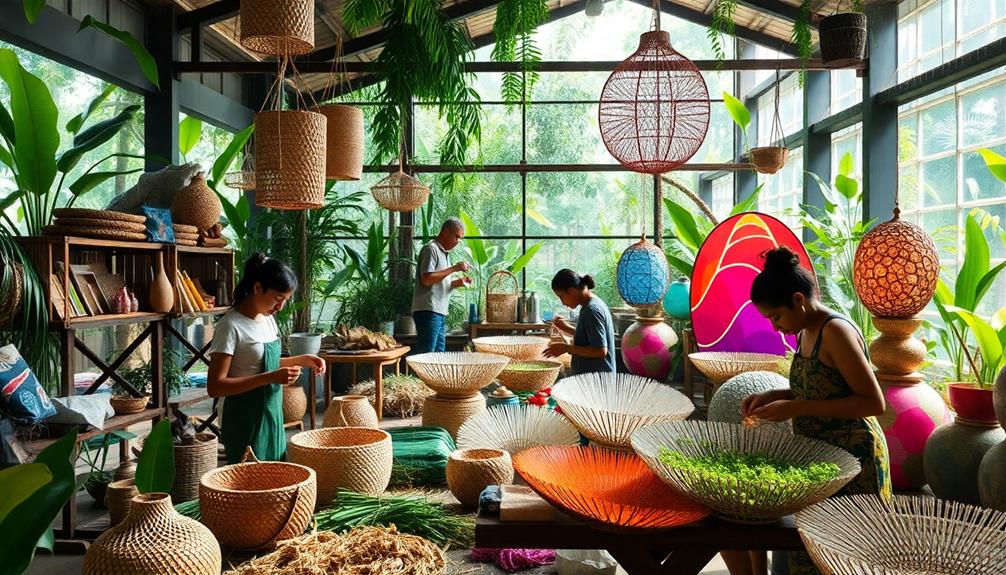
You're about to explore how Indonesia's rich biodiversity inspires innovations in biodegradable materials.
By utilizing local resources and integrating cultural heritage, you'll see how these advancements in packaging technology not only promote sustainability but also celebrate Indonesia's unique identity.
This blend of tradition and innovation opens up exciting possibilities for eco-friendly design, much like the unique artistic expressions found in Indonesian decor.
Local Resource Utilization
In the vibrant landscape of Indonesian design, local materials like cassava plastic and pineapple fibers are reshaping the approach to sustainability. By tapping into Indonesia's rich biodiversity, you can explore innovative biodegradable materials that not only serve practical purposes but also honor the environment.
Designers, such as those at Mahallati Interiors, are leading the way in integrating these sustainable materials into luxury tropical designs, emphasizing both beauty and ecological responsibility.
Consider the potential of these local resources:
- Bamboo: A fast-growing plant used for construction and furniture.
- Seaweed: Harnessed for eco-friendly packaging solutions.
- Kombucha Tea: Emerging as a source for vegan leather and material boards.
- Palm Leaves: Handcrafted into biodegradable plates and utensils.
- Rice Husk: Transformed into durable and compostable building materials.
Utilizing these resources promotes local resource utilization and supports green design principles.
While production remains largely at a small scale, the collaboration between architects, engineers, and material scientists is key to expanding the use of these biodegradable materials in various industries.
By investing in these sustainable innovations, you not only contribute to environmental preservation but also help revive traditional craftsmanship that reflects Indonesia's unique heritage.
Embracing these materials is essential for a sustainable future in design.
Cultural Heritage Integration
Integrating cultural heritage into modern design isn't just about aesthetics; it's about creating a narrative that honors Indonesia's rich traditions while embracing sustainability. By innovating with biodegradable materials such as cassava plastic and pineapple fibers, you tap into the country's diverse natural resources, creating sustainable alternatives that reflect local craftsmanship.
Additionally, the emphasis on modern tropical aesthetics promotes the use of natural materials, which aligns seamlessly with the move toward eco-friendly practices.
Using traditional materials like bamboo and seaweed in your designs not only showcases Indonesia's cultural heritage but also promotes eco-friendly practices. Research into local resources has led to exciting developments in biodegradable products, including coffee-based vegan leather and Kombucha Tea material boards.
These materials minimize environmental impact while connecting to Indonesia's cultural identity.
Emphasizing cultural hybridization allows you to redesign traditional artifacts innovatively, merging the old with the new. This approach paves the way for biodegradable materials to gain acceptance in architecture and design, creating a bridge between sustainability and cultural expression.
Technological Advancements in Packaging
As the focus on sustainability deepens in Indonesian design, technological advancements in packaging are emerging as a vital complement to traditional practices. You'll find that innovations in biodegradable materials are reshaping the landscape, particularly in how products are packaged. These advancements help minimize waste and reduce environmental impacts, making them indispensable for a greener future.
Sustainable decor choices, such as incorporating intricate wooden carvings as decor elements, are also gaining traction within event planning.
Consider these exciting developments:
- Biodegradable coffee capsules that decompose like banana skins
- Packaging materials that leave behind zero microplastics
- Solutions that cater specifically to the hospitality sector
- Products designed with circular economy principles in mind
- Increased awareness and demand from consumers for sustainable options
Companies like Solinatra lead the charge in creating biodegradable materials that guarantee zero harmful contamination. The shift towards these materials is gaining momentum in Indonesia, especially as consumers become more aware of the consequences of single-use plastics.
Challenges in Material Selection

Traversing the landscape of sustainable materials in Indonesian design presents several challenges that can hinder progress.
First, the high costs associated with certified green materials often deter stakeholders from opting for sustainable materials over conventional options. This financial barrier can greatly impact decisions in building construction, where budgets are typically tight.
Moreover, the limited availability of locally sourced sustainable materials complicates efforts to adopt eco-friendly practices. Without access to these resources, architects and builders struggle to implement green designs effectively.
Insufficient knowledge and training further exacerbate the issue, as many professionals lack awareness of sustainable options and their benefits.
Additionally, regulatory inconsistencies and the absence of strong policies supporting the use of sustainable materials create confusion and complicate compliance with national laws.
You might find it challenging to navigate these regulations when trying to incorporate eco-friendly practices into your projects.
Green Building Certifications
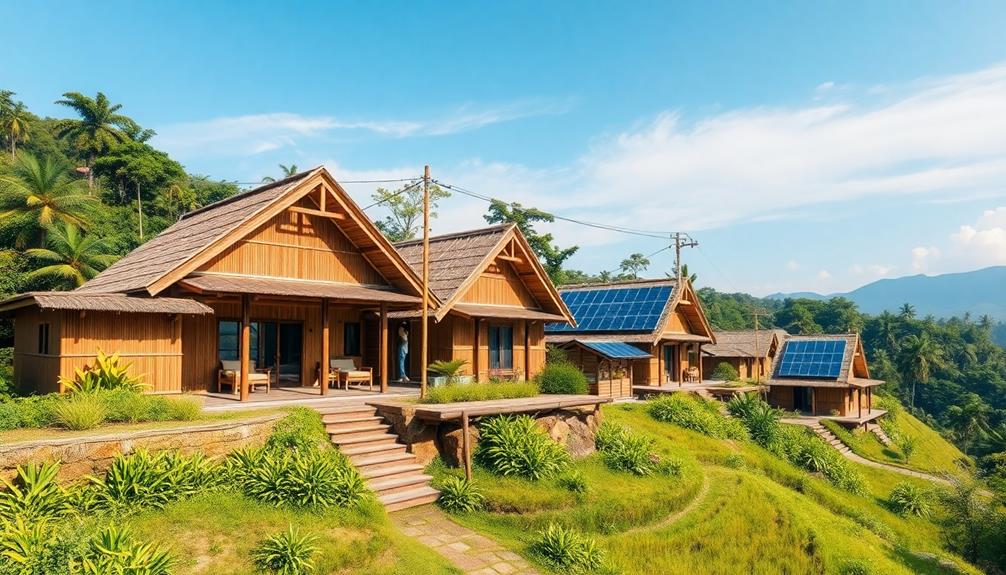
Steering through the challenges of material selection in Indonesian design highlights the importance of green building certifications in promoting sustainable practices. Certifications like EDGE and Greenship 1.2 not only assess but also encourage the use of sustainable materials, enhancing energy efficiency and reducing environmental impact.
With over 1.4 million square meters of buildings certified by EDGE, think about the equivalent environmental benefit of planting approximately 688,510 tree seedlings.
Consider the key aspects that certifications evaluate:
- Lifecycle energy consumption of building materials
- Waste management practices
- Locally sourced materials
- Environmental footprint reduction
- Educational initiatives for better design principles
These certifications have sparked a growing trend in Indonesia, with over 180 green-certified projects, more than half of which are in Jakarta.
Workshops and educational programs organized by institutions like IFC and IAI further deepen your understanding of green building design principles, promoting the adoption of sustainable materials in architecture.
Future of Sustainable Design in Indonesia

The future of sustainable design in Indonesia hinges on the country's unique resources and innovative spirit. You'll see a growing reliance on local green materials like cassava plastic and bamboo, which not only utilize Indonesia's rich biodiversity but also celebrate its cultural heritage.
The Indonesian government's commitment to reducing carbon emissions means sustainable architecture will play a vital role in achieving environmental goals and building urban resilience.
As you explore this landscape, innovative technologies like 3D printing and biomimicry will become essential. These advancements allow for the development of materials and structures that blend seamlessly with the environment.
Consumer demand for eco-friendly products is driving the furniture and construction industries toward sustainability, and the market for green building materials is expected to expand considerably in the coming years.
Collaboration among architects, engineers, and local communities will be key. By working together, they can create sustainable design practices that address environmental challenges and promote economic growth and cultural identity.
The future looks promising—sustainable design isn't just a trend; it's a transformative movement that puts Indonesia on the global map for innovation and sustainability.
Frequently Asked Questions
Why Is It Important to Choose Sustainable Materials?
Choosing sustainable materials is essential because it reduces environmental impact, promotes energy efficiency, and supports local economies. You'll contribute to climate change mitigation while attracting eco-conscious customers who value responsible practices and enhancing your brand's reputation.
Why Choose Sustainable Design?
Choosing sustainable design's like planting seeds for a healthier future. You create lasting beauty while reducing environmental impact and supporting local economies. It's not just a trend; it's a responsible choice for your community and planet.
Why Is It Important to Consider Using Eco-Friendly Materials When Designing?
When designing, considering eco-friendly materials is essential. They lower carbon emissions, support local economies, and attract eco-conscious customers. Plus, using innovative options like bamboo enhances your project's appeal while meeting growing sustainability demands.
Why Is It Important to Use Sustainable Materials in Interior Design?
Imagine a forest whispering secrets of sustainability. By using sustainable materials in interior design, you not only breathe life into your spaces but also protect our planet, reduce waste, and embrace a healthier future for all.
Conclusion
Choosing sustainable materials in Indonesian design isn't just a trend; it's an essential step towards a greener future. Imagine a vibrant community center built from locally-sourced bamboo, reducing transport emissions and showcasing local craftsmanship. This space not only serves as a hub for creativity but also embodies the spirit of sustainability. By embracing these materials, you're not just creating beautiful designs; you're fostering a healthier environment and inspiring others to follow suit.
